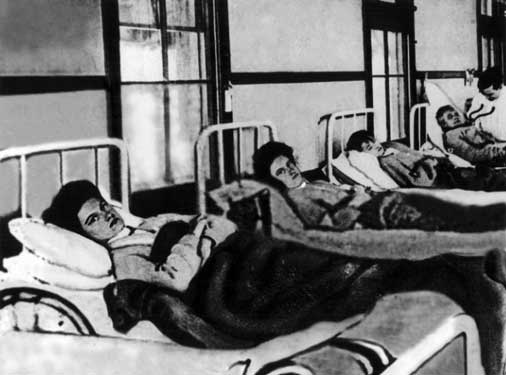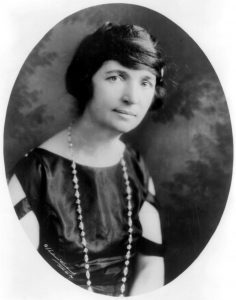Summer of 1906 brought about an unexpected arrival into the Warren’s rented summer household when “… one of the Warren’s daughters became ill. Next, two maids and Mrs. Warren were affected followed by another daughter and the gardener.”1 While summer vacationing in a wealthy neighborhood of Oyster Bay, Long Island, six members in a household became gravely ill with typhoid fever. Prior to this infection case, many people associated typhoid fever infections were usually from the lower class because typhoid was known to be caused by poor sanitation of water and food. The Thompsons, who rented their house to the Warren family, hired George Soper to investigate the cause of the typhoid fever outbreak in the household. They were afraid their house would never be rented again because it was contaminated with the bacteria causing typhoid fever. Soper was a distinguished scholar who had attained his Ph.D in the field of Sanitary Engineer. His previous work with the typhoid epidemic made him vital as an epidemiologist working for the Department of Health.2

Soper began by thoroughly and systematically investigating all the known facts that had been presented to him, and one by one he ruled out all types of potential sources of infection. Finally, he found that the family had changed cooks prior to the family’s typhoid fever attack.3 Due to Soper’s previous medical investigations, he was well aware that a person can be a healthy carrier of certain diseases, and typhoid was one of them. This means that a person could be infected by some type of a pathogen and they would not demonstrate any symptoms. Due to this, the person would seem healthy and not a menace to society. While the person may seem healthy, they can become the driving force that helps spreads the pathogen. This phenomenon occurs in about 3% of patients who recover from the bacterial infection that causes typhoid fever.4
Bacteria have evolved alongside humans in order to successfully infect themselves into a human host. Pathogens continue to spread into the human population, which can be seen in the case of Salmonella typhi that infected Mary Mallon, the family’s cook. Though she was never gravely ill from her infection, the pathogen had embedded itself within her body and it used her as a vessel to bring the infection to many unsuspecting people. Due to the number of people she infected, she became known as Typhoid Mary as she unknowingly infected fifty-one people with her cooking, which ultimately led to the deaths of three people.5
Mary Mallon, an Irish immigrant, became the first known asymptomatic carrier of typhoid fever. Her work as a cook placed everyone who ate her food at great risk of getting typhoid fever.6 A bacterial infection that causes typhoid fever to occur can be passed via fecal matter or contaminated water used to cook food. Once this type of bacteria enters the human body, it primarily lives in the stomach until it progresses into the lymphatic system and finally, makes its way to the bloodstream, where it is spread throughout the rest of the body.7 Mallon posed a great risk to societal health, but more specifically to those she cooked for, especially when she made her famous and well-loved desert peach ice cream. High heat kills the typhoid causing bacteria; however, in cold foods the bacteria is placed in a frozen state. Once in the human body, it metastasizes and eventually enters the bloodstream and there it facilitates its spread throughout the body.

Antibiotics that could treat bacterial infections such as typhoid fever were not introduced to the until the early 1940s. Therefore, during the late 1870s, only the symptoms caused by the infection such as fever, fatigue, joint pain, headache, constipation, and a rash consisting of a rosy pink color spotted across the abdomen could be treated by physicians until the body completely fought off the bacterial infection on its own.8
After Soper tracked down Mallon, who had been employed as a cook for another wealthy family after leaving the Warrens, he asked her for a sample of her fecal matter, as asymptomatic carriers have the bacteria in their stool. He needed the sample in order to properly investigate for the typhoid-causing bacteria so he could soundly confirm that she was the source that infected the Warren’s family. Unfortunately, Mallon refused and chased Soper out of the house, stating that it was impossible for her to be the source. She had never contracted the disease and she had been completely healthy throughout her stay with the Warrens. Even while treating the sick, she never became ill herself.9 Soper’s accusations were not well received because Mallon heavily relied on her cooking skills as her source of income. Furthermore, if she were infecting people with the bacteria known for causing typhoid fever, then she would never be hired as a cook again. Mallon did not know that she was carrying the disease, and more importantly, she did not know that through her cooking she could spread the bacteria, so she could not believe she was infecting anyone through her cooking.
With the help of New York City Department of Health, Soper was able to track down Mallon once again and have her removed from society as she continued to infect the families for whom she cooked. After her removal, she was placed on North Brother Island, an island where many other patients infected with deadly diseases lived because they posed serious health risks for the larger public. Her only crime was being a carrier of typhoid and for this she was sentenced to live on an island. Alongside many other people who carried grave and highly infectious diseases that Mallon was not immune to, she was being placed in an environment that left her vulnerable, free today and held captive on an island the next day. Her freedom was stripped away from her as she was forced to live away from her family, friends, and anyone she knew. While living on this island, Mallon received the help of other doctors who argued not only had the Department of Health grossly abused their power by removing Mallon from society, but they deprived her of her right to happiness, and she planned to sue. Many doctors also argued that if Mallon trained to do another type of job that was not food related, then she would not be able to infect people. The bacteria posed no health threats once outside the host body.10 Mallon challenged America’s Public health system and won. After three years of living in isolation, Mallon was free to go, on one condition: that she may never become a cook again. With the help of the judge who was on her case, she became employed as a laundress; however, this job proved not be as lucrative as her cooking job.
The Department of Health realized that of those who had survive typhoid fever, 3% of them would became asymptomatic carriers of the pathogen. As the number of survivor grew so did the number of asymptomatic carriers. The New York City’s Health Department knew that they had to specially retrain all food handler who had became asymptomatic carriers of typhoid fever. The city also employed other ways of minimizing infection such as paying typhoid fever carriers not to go to work, in efforts to minimize potential typhoid outbreak case.
The city of New York was doing very well until a typhoid fever broke out in a hospital, and twenty-five people become infected with typhoid and two of them died. The source of the bacteria was unknown. When further investigation was conducted by Soper, he found out that some of the other kitchen workers nicknamed the newly hired cook as Typhoid Mary. It was not long until Mallon was found, and in 1915 she was apprehended by Public Health officials. Without a fight she cooperated with the Health department and went to live on the island she had successfully and legally left, only to return four years later.11 The moment she broke the only agreement with the judge was the moment that sealed her fate. She was allowed to leave the island periodically to visit family, shop, and integrate herself into society away from the island, while being supervised.

The name Mary Mallon might be lost in the pages of history, but the infamous Typhoid Mary will continue to live on as the first known carrier of typhoid. Throughout her debacle she fought for her human rights and was unafraid to challenge the Health Department’s approach to people who were asymptomatic carriers of typhoid fever. Her story will forever be a potent symbol of America’s fear of diseases.
- Judith Walzer Leavitt, Typhoid Mary (Beacon Press, 1996), 15. ↵
- Judith Walzer Leavitt, Typhoid Mary (Beacon Press, 1996), 15. ↵
- Judith Walzer Leavitt, Typhoid Mary (Beacon Press, 1996), 16. ↵
- Encyclopedia of Medicine, 2016, s.v. “Typhoid Fever.” ↵
- Encyclopedia Britannica, November 15, 2017, s.v.”Typhoid Mary.” ↵
- Jennifer Ashley Wright, Get well soon: History’s Worst Plagues and the Heroes Who Fought Them (New York : Henry Holt and Company, 2017), 77-79. ↵
- Encyclopedia of Medicine, 2016, s.v. “Typhoid Fever.” ↵
- New World Encyclopedia, 2017, “Typhoid Fever.” ↵
- Judith Walzer Leavitt, Typhoid Mary (Beacon Press, 1996), 15. ↵
- Encyclopedia of Medicine, 2016, s.v. “Typhoid Fever.” ↵
- NPR.org, October 30, 2014, Awful Moments In Quarantine History: Remember Typhoid Mary? ↵



79 comments
Angel Torres
The story of Typhoid Mary depicts the troubled side of when public health becomes threatened. It shows how fast a bacteria can spread through out society through someone that does not know they are infected. The Department of Health sentenced Mary to live on an island to prevent the contamination of any other members of society. We are now lucky enough to have technological advances and procedures that will contain spread of diseases. The article was very informative and provided a well explanation behind the typhoid disease and as to what asymptomatic carriers are.
Eloisa Sanchez Urrea
It is scary to think that there are so many life threatening infections, and the most dangerous may be the most silent. Reading articles like these also helps me realize how far medicine has come. We now have antibiotics and are able to quarantine in ways that don’t require being sent to an island. This article did leave me with so many questions about the island.
Micaela Cruz
I enjoyed reading this article, it was the title that caught my attention. The story of Mary Mallon is an interesting one. It’s crazy to think that someone you know could be walking around with a disease that could potentially kill others but not even that person knows. I find it rather disturbing how even after she was released back into society and instructed not to work as a cook again, Mallon went back to work… as a cook. Did she not learn from her first experience?
Brianna Ford
I never heard of this disease until I read this article. It is scary to know that someone can carry something but still appear perfectly normal. Its sad that Mary had to live in isolation all because of what she had, I couldn’t imagine the U.S doing that in today’s society. This article was a good read and has me wanting to search some more about this particular disease.
Steven Hale
At first, I was shocked that Mary could be remanded for life at a place where she could become infected by the other diseases and die a painful and early death. However, after she became a cook the second time, she did so knowing that she could kill whoever consumed the food. I stopped feeling sorry for Mary after that instance. It is a little scary that anyone we come into contact with could be a healthy disease carrier.
Hailey Stewart
The scariest types of diseases are those that do not display symptoms until it is well into its stages. Typhoid is one of those pathogens, which is also very contagious. This article was very informative, and the title is a good hook. It is unfortunate that this pathogen was spread so widely so unknowingly. Reading about public health in times well before modern technology is very intriguing but also scary.
Clarissa Gonzalez
I’ve heard this before in one of my science classes last year, but this was a new view. It was scary knowing that this can still happen because we never know who is cooking our food and how they’re cooking it. Also, I didn’t know what asymptomatic person was until I read this article. Mary wasn’t sick, but she was a reason people could get sick.
Maisie Favila
I didn’t know anything about this before I read this article, so I’m glad I did! Mary’s story is so interesting to have read about and I feel like this article was well written in general. It’s crazy that a perfectly healthy person could be carrying such a horrible virus without even knowing. I find it tragic that she had to be isolated because of something that was out of her hands, but she did break the rules so she brought it upon herself.
Roman Olivera
While reading this article I felt bad Mary Mallon, first for getting the nickname Typhoid Mary, then for getting sent to the island that held people with infectious diseases. it was wrong to strip her of freedoms for something she did not know was effecting others with, through her cooking. Then after she was given her freedom back , she knowingly infected people with a potentially life threatening disease. I definitely think she deserved to be on that island. I wonder if that’s were we got laws for knowingly infecting people with communicable diseases. Something to look up I guess. Could you imagine if America still used the practice of sending people to islands for having infectious disease. HIV, AIDS, HPV, Herpes, cold sores, the flu…man no body would make it. We would have no body left. Great article about Typhoid Mary, it really got me thinking.
Christopher Hohman
Nice article. I feel really bad for Mary Mallon. She had no control over what pathogens she carried asymptotically. She was probably a good person, but just hated her other job as a laundress, so she decided to try her hand at cooking again. When the city of New York removed her from society I felt bad for her. To put her with all those others who were carrying more deadly diseases than her. That is just a terrible thing to do. The name Typhoid Mary is unfair and just mean